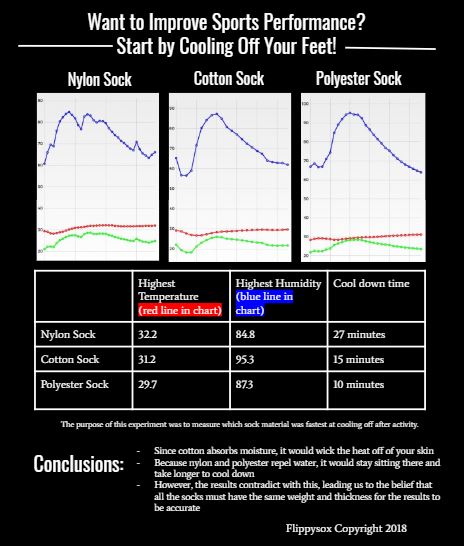Want to Improve Sports Performance? Start Off By Keeping Your Feet Cool!

Did you know that the first ‘humidity sensor’ was hair attached to the end of a nail?
Hello and welcome to the final post of the electronic sock series! In this post, we are experimenting with nylon, polyester, and cotton socks to see which type works best to cool your feet when doing sports/activities. We are going to use our specially designed sock pocket to hold an electronic sensor that measures humidity and temperature. We are assuming that as the foot sweats, that the inside of the sock will get more humid and the sensor will record that. Using a temperature sensor is also interesting because we can see how the temperature in the sock changes over time.
Both humidity and temperature were recorded every minute by the device. We will start the experiment by putting one of the three sock types on and run around for a certain distance. Then, we will wait for the sock to cool down until it is back to the point we started at. This is called the cool down time. After that, we will take a look the data from all sock materials and compare them!
Check out the results in the image!
Polyester: this material should not absorb water/sweat (hydrophobic) so we should expect HIGH humidity but instead the sensor measured LOW humidity
Nylon: this material should not absorb water/sweat (hydrophobic) so we should expect HIGH humidity but instead the sensor measured LOW humidity
Cotton: this material should absorb water/sweat (hydrophillic) so we should expect LOW humidity but instead the sensor measured HIGH humidity
What happened? We believe there are also other factors that affect how well the sock cools down the foot such as the holes or gaps in the fabric or the gsm (grams per square meter) of the material. If there are larger holes and a thin material, that means that the foot should cool off faster (sweat is being evaporated quicker) whereas if there were small holes and a thicker material it would have be slower cooling. Our sample polyester and nylon socks were very thin and seemed to have less weight whereas our cotton sock was thicker and heavier. Because of this, we cannot fully determine which material was truly the best at cooling off. To do that, we’d have to have the same thickness and weight of the different sock materials. In conclusion, to help keep your feet cool make sure to go for sock materials that absorb water and are thinner!

Recent Comments